-
EngineSC 6.2L V8
-
Power707 HP / 650 LB-FT
-
Transmission8-Speed Auto
-
0-60 Time3.7 Seconds
-
Top Speed204 MPH
-
DrivetrainRear-Wheel Drive
-
Engine PlacementFront
-
Curb Weight4,575 LBS
-
Seating2+3
-
Cargo16.5 CU-FT
-
Base Price$63,995
Including all-wheel-drive models, there are ten versions of the 2015 Dodge Charger. The tenth variant – better described as the ten-tenths variant and the topmost model – is this Charger SRT Hellcat.
Superficially, you already know what it is: take the massively powerful Hellcat engine that's Frankensteined into the Dodge Challenger and stitch it into the recently facelifted Charger sedan.
Oh, but that would be superficial knowledge indeed. Russ Ruedisueli, vehicle line executive and head engineer for SRT, claims the Charger Hellcat is, "The industry's most irreverent four-door supercar." We looked up the word "irreverent" in the Oxford dictionaries, and it turns out the word doesn't mean "707 horsepower," nor "650 pound-feet of torque" nor "3.7-second 0-60 time, and seats five adults." It does mean, "Showing a lack of respect for people or things that are generally taken seriously."
After a day piloting SRT's latest brute through the hills and dales surrounding our nation's capital, we've found that definition leaves the driver a fair bit of work to do. While the Charger SRT Hellcat is busy being contemptuous, pouring its profane growl all over the roads, if you have any sense at all, you will Respect it with a capital "R" and take it very, very seriously.
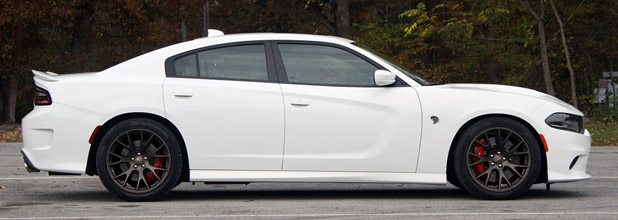
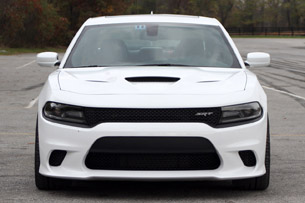
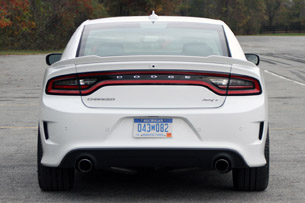
Ruedisueli tells us that a fair percentage of Charger owners take their cars to the track, so SRT took pains to make sure the engine could stand the literal heat. Chrysler thus bought a few supercharged competitors and found that they couldn't handle 20 minutes of hard track duty in hot weather, so SRT engineers realized they had underestimated the task's cooling requirements. Where you would expect to find foglights in the flanks of the front lower bumper, SRT has instead installed additional cooling: a separate, high-capacity water cooler for the supercharger – which takes 80 hp to run – on the right, and a high-capacity oil cooler on the left.
Dodge's press materials vow the Charger SRT Hellcat is good for 20 minutes of track duty in 100-degree weather, and it's possible to reduce temperatures further by removing the lower grille, held in place with eight screws. You couldn't run the whole 20 minutes at Nardo's high-speed oval, though. With an upgraded pump and larger, half-inch fuel lines required to feed the Hemi-orange-shaded monster, you'd run though a full tank of gas in 13 minutes.
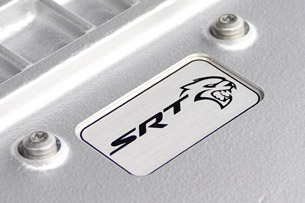
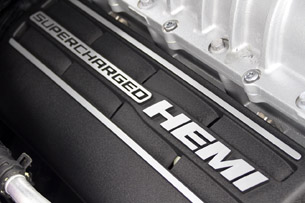
That driveline heart is wrapped in a body that's been entirely resculpted, with just the roof and the rear doors avoiding the scalpel. The standard Charger's new visual similarity to the Dart in front seems to cleave opinion right down the middle, but changes made to SRT models should help add a few "yea" votes. The Charger has a serious mien in Hellcat guise thanks mainly to the jettisoning of the crosshair grillework of lesser models, which has been replaced by black mesh split by a body-colored bumper. It's all aided by a NACA duct flanked by extractors in the aluminum hood and the visual forward lean of the nose. This might be the meanest-looking production sedan on the road.
Behind that nose, the front doors get a more relaxed scallop, the C-pillar lands on the rear fenders three inches further rearward, stretching the greenhouse and shortening the back end, and the LED 'racetrack' taillights emit a diffuse glow, as on the Durango. At the top of the new rear fascia is a one-piece spoiler and there are twin four-inch tailpipes that can't help but let the world know who you are and what evil you intend.
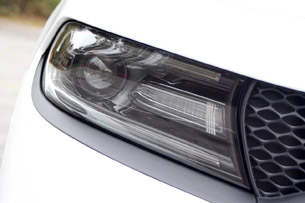
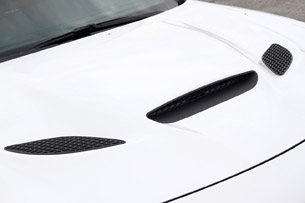
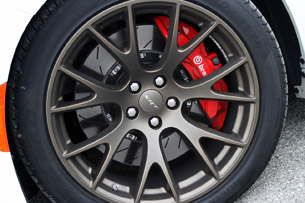
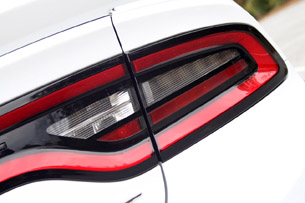
We weren't fans of the previous electronic shifter – you'd tap it to change gear, but it didn't move intuitively. Customers apparently weren't fans, either. Thus, there's a new gearlever at hand. It's still all electric, but it feels like a linkage shifter and behaves more intuitively.
The dash cluster and infotainment area has carbon fiber facing and a one-piece aluminum bezel, and there's a 200-mph speedometer that, technically, is four mph short of the Charger SRT Hellcat's top speed. Which means it's faster than its two-door Challenger cousin.
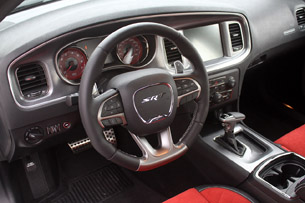
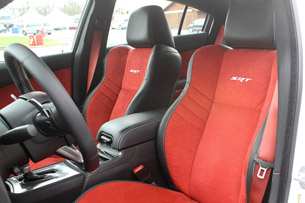
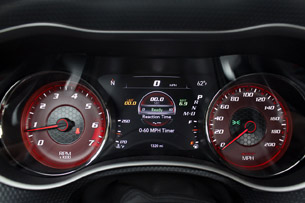
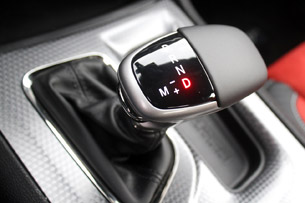
The first thing you should know about the Charger Hellcat is the way it sounds. Formula One got beat like a goat earlier this year because rule changes meant that all of a sudden, the series didn't sound better than GP2.
The Charger Hellcat goes the other way.
We watched five of them shoot down the 2,900-foot main straight of Summit Point Raceway in West Virginia, and suspect if you blindfolded Le Mans and FIA GT fans and offered them a million dollars to identify the car jolting the woods with an interplanetary basso profundo ruckus, you'd have gone home with a million dollars. The closest they would have gotten is, "Well... since SRT doesn't race anymore... the Corvette C7.R?" And we mean that as the highest compliment. If you told them, "No, it's a 4,500-pound family sedan," they'd say, "Shut up. Prove it."
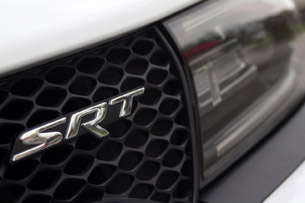
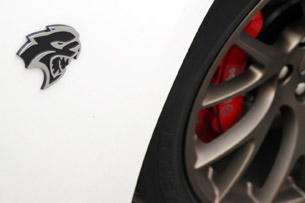
Keep the engine up by its boiling point, though, and everything flows. The transmission's 160-millisecond shifts match the overall fury of the experience with practically imperceptible downshifts. Thenew electronically assisted power steering hydraulically assisted power steering is light on feedback, but accurate and pleasingly weighty (the non-SRT models have moved to electrically-assisted power steering). Of course, when you're high on speed, you can steer with the throttle and not worry about 707 horses suddenly galloping out the back all end at once. The Track mode stability control lets you hang the tail out, yet there's still leeway at the limit, so the car can let you know you're asking too much. Bilstein shocks keep pitch and yaw where you want them. To gauge the differences in the driver-selectable mode setting, we ran the track once in Street mode, a setting that required braking earlier and taking an entirely different line through hard corners due to more body roll and slower steering.
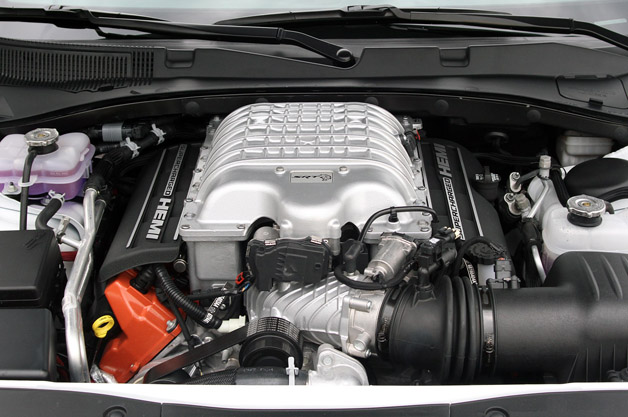
During Hellcat track drives, we had to ride with a pro driver, and an excellent instructor named Mike aided our experience. Fearless in spite of our journalist pedigree (and despite the obvious subtext of Dodge's safety briefing being, "Please don't drive our cars into the tire barriers") Mike kept saying, "Get off the brake!" and "You can go faster!" So we got off the brake and we went faster. And yes, the Charger SRT Hellcat is a big, heavy muscle car, and it can do what it does because of power and not courtly finesse. But it's got muscle in all the right places, with both primetime bulk for speed and supplemental brawn to do more than just go fast in a straight line. Those owners who plan to track their cars will have a monumental time and make monumental noise doing it.
We wrangled a Hellcat for the 75-mile drive back from Summit to DC, made longer and slower because of rush-hour traffic and storms. Whereas Miersma got to test the Challenger SRT Hellcat "on some truly lovely roads along the Columbia River" in Oregon, rural West Virginia and Virginia roads are generally straight and narrow. Naturally, while we were there, they were saturated with speed traps.
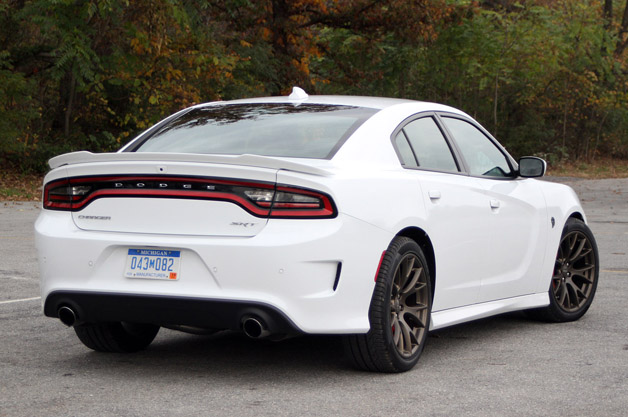
But you're never "just" in a Charger. When traffic thickened and our speed was limited to single digits, we felt like the Decepticon Barricade, hunting our way back to the hotel, our SRT's four-inch tailpipes growling their disdain at puny human company. When traffic opened up, we couldn't help punching it at 55 mph, snagging a dose of supercharger whine as the gearbox bungee-jumped from eighth to third gear. Seconds later, we'd be on the brakes as our speed whiplashed into license-revoking territory. The only impediment we encountered to daily-driver ease was when parallel parking – sometimes the steering assist wouldn't kick in, making it a workout to get all that rubber up front pointed the right way.
We'd take the Charger SRT Hellcat over the Challenger version, because, incredibly, the smaller Challenger feels much larger on the road. We'd take the SRT Hellcat because it's got everything you want in a Charger and a whole lot of stuff you want in your dreams. We'd take it because, as far as American chutzpah goes, it's the Rocky Balboa of muscle sedans.
Superficially, you already know what it is: take the massively powerful Hellcat engine that's Frankensteined into the Dodge Challenger and stitch it into the recently facelifted Charger sedan.
Oh, but that would be superficial knowledge indeed. Russ Ruedisueli, vehicle line executive and head engineer for SRT, claims the Charger Hellcat is, "The industry's most irreverent four-door supercar." We looked up the word "irreverent" in the Oxford dictionaries, and it turns out the word doesn't mean "707 horsepower," nor "650 pound-feet of torque" nor "3.7-second 0-60 time, and seats five adults." It does mean, "Showing a lack of respect for people or things that are generally taken seriously."
After a day piloting SRT's latest brute through the hills and dales surrounding our nation's capital, we've found that definition leaves the driver a fair bit of work to do. While the Charger SRT Hellcat is busy being contemptuous, pouring its profane growl all over the roads, if you have any sense at all, you will Respect it with a capital "R" and take it very, very seriously.



Autoblog colleague Seyth Miersma recently took us on a tour of the internal changes made to the 392-cubic-inch Hemi V8 in the SRT 392 – with 485 hp and 475 lb-ft of torque – that strengthen it for freakish duty, including the 2.38-liter IHI supercharger that makes the engine a Hellcat. Everything that is in that car is also in this model, however, we have discovered an important detail in this car's construction.A fair percentage of Charger owners take their cars to the track, so SRT took pains to make sure the engine could stand the literal heat.
Ruedisueli tells us that a fair percentage of Charger owners take their cars to the track, so SRT took pains to make sure the engine could stand the literal heat. Chrysler thus bought a few supercharged competitors and found that they couldn't handle 20 minutes of hard track duty in hot weather, so SRT engineers realized they had underestimated the task's cooling requirements. Where you would expect to find foglights in the flanks of the front lower bumper, SRT has instead installed additional cooling: a separate, high-capacity water cooler for the supercharger – which takes 80 hp to run – on the right, and a high-capacity oil cooler on the left.
Dodge's press materials vow the Charger SRT Hellcat is good for 20 minutes of track duty in 100-degree weather, and it's possible to reduce temperatures further by removing the lower grille, held in place with eight screws. You couldn't run the whole 20 minutes at Nardo's high-speed oval, though. With an upgraded pump and larger, half-inch fuel lines required to feed the Hemi-orange-shaded monster, you'd run though a full tank of gas in 13 minutes.


The same beefed-up, eight-speed TorqueFlite transmission gets the power to the rear wheels, with said 20-inch footgear wearing 9.5-inch-wide Pirelli PZeros or PZero Neros on forged-aluminum Slingshot wheels. Lurking behind them are six-piston Brembo brakes in front, clamping down on 15.4-inch, two-piece, vented and slotted rotors, and there are matching four-piston units in back that grab slightly smaller 13.8-inch discs.This might be the meanest-looking production sedan on the road.
That driveline heart is wrapped in a body that's been entirely resculpted, with just the roof and the rear doors avoiding the scalpel. The standard Charger's new visual similarity to the Dart in front seems to cleave opinion right down the middle, but changes made to SRT models should help add a few "yea" votes. The Charger has a serious mien in Hellcat guise thanks mainly to the jettisoning of the crosshair grillework of lesser models, which has been replaced by black mesh split by a body-colored bumper. It's all aided by a NACA duct flanked by extractors in the aluminum hood and the visual forward lean of the nose. This might be the meanest-looking production sedan on the road.
Behind that nose, the front doors get a more relaxed scallop, the C-pillar lands on the rear fenders three inches further rearward, stretching the greenhouse and shortening the back end, and the LED 'racetrack' taillights emit a diffuse glow, as on the Durango. At the top of the new rear fascia is a one-piece spoiler and there are twin four-inch tailpipes that can't help but let the world know who you are and what evil you intend.




The substantially upgraded interior applied to the Charger for 2015 has been further enhanced with SRT accessories like the thick, heated – and rather large – almost-flat-bottomed steering wheel with larger buttons, paddle shifters and optional surface treatments like the black leather against ruby red Nappa leather and Alcantara seen here.There's a 200-mph speedometer that, technically, is four mph short of the Charger SRT Hellcat's top speed.
We weren't fans of the previous electronic shifter – you'd tap it to change gear, but it didn't move intuitively. Customers apparently weren't fans, either. Thus, there's a new gearlever at hand. It's still all electric, but it feels like a linkage shifter and behaves more intuitively.
The dash cluster and infotainment area has carbon fiber facing and a one-piece aluminum bezel, and there's a 200-mph speedometer that, technically, is four mph short of the Charger SRT Hellcat's top speed. Which means it's faster than its two-door Challenger cousin.




We suspect that no matter how spiffy the cabin, Dodge would need to channel its inner Dartz and slather the Hellcat's interior in whale penis leather for anyone to really pay attention to it. When Chrysler's morning presentation was finished, everyone wanted to drive the engine – the cockpit was little more than a convenient way to be able to do it.The first thing you should know about the Charger Hellcat is the way it sounds.
The first thing you should know about the Charger Hellcat is the way it sounds. Formula One got beat like a goat earlier this year because rule changes meant that all of a sudden, the series didn't sound better than GP2.
The Charger Hellcat goes the other way.
We watched five of them shoot down the 2,900-foot main straight of Summit Point Raceway in West Virginia, and suspect if you blindfolded Le Mans and FIA GT fans and offered them a million dollars to identify the car jolting the woods with an interplanetary basso profundo ruckus, you'd have gone home with a million dollars. The closest they would have gotten is, "Well... since SRT doesn't race anymore... the Corvette C7.R?" And we mean that as the highest compliment. If you told them, "No, it's a 4,500-pound family sedan," they'd say, "Shut up. Prove it."


Behind the wheel, the Charger Hellcat will mind the driver's leash, but it runs best when it's pushed to make all that noise. When put in Track mode – recommended only for smooth surfaces – the exhaust, steering, transmission and three-mode suspension are fixed at their fiercest settings. In this mode, the Charger does just about everything quickly. From a standstill, throttle tip-in gives so much juice that concentration is necessary to avoid chirping the wheels when pulling out of the pits. When running at less than seven-tenths around the circuit, even in Track mode, the transmission will choose a loping gear; then, when a paddle trigger is pulled, the gearbox executes a few chunky downshifts to get its race face back on.Keep the engine up by its boiling point and everything flows.
Keep the engine up by its boiling point, though, and everything flows. The transmission's 160-millisecond shifts match the overall fury of the experience with practically imperceptible downshifts. The

Get your line right out of the last corner and you could get well into the 140s by the time you hit the braking zone for the first corner hairpin. We had been asked to start braking at the first marker, but the Brembos are so good that hard deceleration had us at the ideal cornering speed before we'd passed the last brake-zone marker. They're the kind of brakes we thought were journalist-proof until another driver rode straight off into the gravel. We can assure you that the mishap was not due to inadequate stoppers.But it's got muscle in all the right places, with both primetime bulk for speed and supplemental brawn to do more than just go fast in a straight line.
During Hellcat track drives, we had to ride with a pro driver, and an excellent instructor named Mike aided our experience. Fearless in spite of our journalist pedigree (and despite the obvious subtext of Dodge's safety briefing being, "Please don't drive our cars into the tire barriers") Mike kept saying, "Get off the brake!" and "You can go faster!" So we got off the brake and we went faster. And yes, the Charger SRT Hellcat is a big, heavy muscle car, and it can do what it does because of power and not courtly finesse. But it's got muscle in all the right places, with both primetime bulk for speed and supplemental brawn to do more than just go fast in a straight line. Those owners who plan to track their cars will have a monumental time and make monumental noise doing it.
We wrangled a Hellcat for the 75-mile drive back from Summit to DC, made longer and slower because of rush-hour traffic and storms. Whereas Miersma got to test the Challenger SRT Hellcat "on some truly lovely roads along the Columbia River" in Oregon, rural West Virginia and Virginia roads are generally straight and narrow. Naturally, while we were there, they were saturated with speed traps.

In Default and Sport mode, the SRT Hellcat is an everyday-driver Charger, with all the convenience of its less-spicy siblings. Adaptive cruise control with full stop, Uconnect infotainment, an excellent seven-inch in-dash display and a bag of available safety features including blind spot monitoring, lane departure warning and backup camera help make this four-door a surprisingly docile daily driver.It's got everything you want in a Charger and a whole lot of stuff you want in your dreams.
But you're never "just" in a Charger. When traffic thickened and our speed was limited to single digits, we felt like the Decepticon Barricade, hunting our way back to the hotel, our SRT's four-inch tailpipes growling their disdain at puny human company. When traffic opened up, we couldn't help punching it at 55 mph, snagging a dose of supercharger whine as the gearbox bungee-jumped from eighth to third gear. Seconds later, we'd be on the brakes as our speed whiplashed into license-revoking territory. The only impediment we encountered to daily-driver ease was when parallel parking – sometimes the steering assist wouldn't kick in, making it a workout to get all that rubber up front pointed the right way.
We'd take the Charger SRT Hellcat over the Challenger version, because, incredibly, the smaller Challenger feels much larger on the road. We'd take the SRT Hellcat because it's got everything you want in a Charger and a whole lot of stuff you want in your dreams. We'd take it because, as far as American chutzpah goes, it's the Rocky Balboa of muscle sedans.










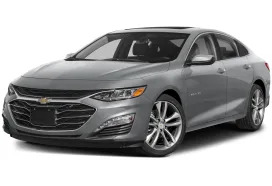


Sign in to post
Please sign in to leave a comment.
Continue